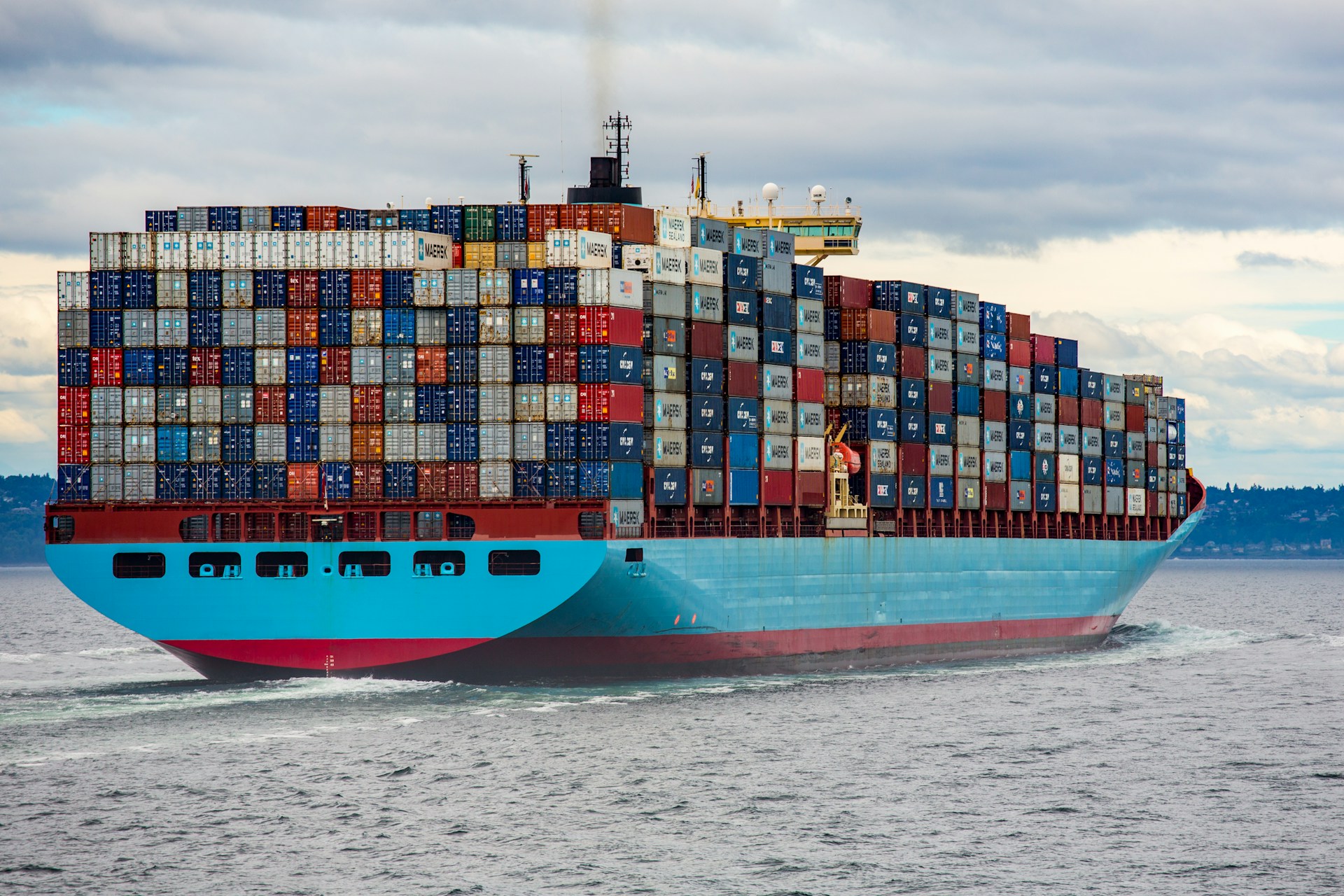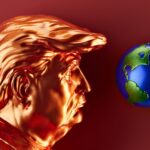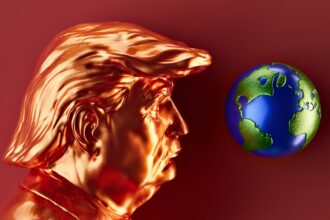The world economic order is changing, driven above all by the American turn against free trade. Here are some predictions about how world trade is going to shift in the next few years.
World trade volumes will continue to increase by on average 3% per year over the next 5 years. 60% probability
Since 2008, the dawn of the current economic era, annual trade volume has increased on average by around 2.8% (this figure is lowered slightly by the extraordinary events of 2020-2022). US trade policy will negatively impact this, but by far less than it would have done a few decades ago. The US now accounts for only around 13% of global imports, down from around 20% at the turn of the millennium. US protectionism will accelerate this trend and possibly reduce overall US trade with the rest of the world, but increased trade flows everywhere else will easily make up for US relative decline.
Energy shocks and supply side bottlenecks which hit global trade in the last few years (slowing increases to 1.2% and 2.6% in 2023 and 2024) have eased, and outside of the US, commitment to global trade remains what it was. The other two global trade blocs, the EU and China, will continue to recognise the benefits of increased trade flows. The EU has free trade hardwired into its operating procedures, and the interests of key members will prevent anti-trade members from shifting this significantly. China’s mercantilism is long-established, but its dependence on exports gives other countries leverage and China an incentive to negotiate. US political turmoil will serve as a lesson to other major countries about what route not to go down – President Trump may have done more to advance the intellectual and political case for free trade than any world leader since Ronald Regan or Margaret Thatcher.
There are downside risks to overall trade flows. The EU is concerned about Chinese offloading of extra capacity resulting from US tariffs, Chinese domination of rare earth production, security infiltration through technology products, and general human rights abuses. This may result in a major China-EU trade dispute, but as I will discuss shortly, this is not a probability. Individual countries within the EU may turn against trade due to internal politics, but the EU’s restrictive collective approach will limit the impact of this. Chinese competitors such as Vietnam or India will significantly increase their global trade share as developed countries hedge against problems with China. The developing world generally will continue its uneven global integration. The US will continue to be the most significant player in the world economy, but its dominance will continue to decline relatively.
Average tariff levels between non-US countries will decrease between now and 2030. 70% probability
No bloc other than the US has the wherewithal or motivation to increase barriers to trade. In fact, momentum elsewhere in the world remains in favour of tariff reduction, which may be even pushed forwards by reaction against US policy.
The EU is currently pursuing trade talks with (amongst others) India, Indonesia, Mexico, Australia and MERCOSUR. While individually each of these negotiations faces formidable political challenges, there is a high chance that at least a few of them will cross the line in the next five years. Agreements, particularly with India, Mexico and MERCOSUR, have the potential to significantly broaden and deepen trade flows between major trade blocs.
There is significant political momentum in Africa for reducing barriers to trade. The African Continental Free Trade Area is picking up genuine momentum for the first time in the history of the continent. To date, 24 countries are using AfCFTA trading frameworks, up from just seven in 2023. The exceptionally low regional economic integration in Africa means that despite the continent’s huge challenges, there are a lot of low-hanging fruit to collect.
Other key regional trade agreements, such as the CPTPP, are also engaged in a medium-to-long expansion project. Momentum for these is likely to accelerate. Global political polarisation will mean that protectionism will become tainted by association with Donald Trump, and moderate or liberal political actors will be thus more open to free trade. A risk which may upwardly influence barriers to trade is conflict between China and the EU, which may provide political cover in the EU to restrict trade with China. However, as discussed in the next point, this is a possibility, not a probability.
EU tariffs on Chinese EVs will decrease from their current levels over the next two years. 75% probability
The EU imposed anti-subsidy tariffs in October 2024 on Chinese EV manufacturers, reflecting concerns about unfair subsidies and predatory pricing. However, the EU remains an incoherent bloc with multiple levels of decision making and economic and political interests. Various manufacturers, including BYD, Tesla, and BMW have challenged the decision in the European Court of Justice. This court challenge has at least a significant possibility of success, which would undermine the application of the European Commission’s decision on tariffs.
Sustained EU action is also hamstrung by country divisions. BMW’s involvement in the court case reflects German interest in maintaining cordial trade relations with China, which is Germany’s largest export destination after the US. Given exports’ key importance to the Germany economy, and given ongoing tensions with the US, it is against Germany’s interest to seriously damage the EU’s trade relations with China. Germany’s continued decisive weight in EU decision making means that despite EU worries about dumping as Chinese firms unload excess capacity in Europe, the EU will not sustain the unanimity needed to implement and maintain meaningful trade-restrictive measures.
Other significant EU countries will also make it difficult for the bloc to retain a united front in a trade confrontation. Dutch and Belgian exports to China constitute an even larger share of GDP than in Germany (2.4% and 1.98% vs 1.91%). Other important countries such as Italy, Greece and Hungary are favourable to China on economic or ideological grounds. China will continue to conduct bilateral diplomacy to undermine EU collective action. The political momentum needed for the EU to meaningfully confront China on trade will thus continue to be lacking.
The structure of the current tariffs also reflects the EU’s leverage. China’s interest is in selling to Europe, which will not be served by a trade war. The same applies to individual companies. Manufacturers who cooperate with the anti-subsidy regime can achieve a reduction in tariffs (such as the Tesla plant in Shanghai). More manufacturers will seek accommodation with the EU regime, while the EU and China seek compromise over alternative schemes such as minimum price schemes. While there will continue to be tensions and dissenting voices, a sustained trade conflict between China and Europe suits neither side.
No EU company will attain a market share of above 5% in EU markets for AI, cloud computing, search engines or operating systems. 90% probability
EU leaders have increasingly worried about foreign, mainly US, dominance of key technology sectors. Henna Virkkunen, the Finnish EU tech commissioner, has added the term “tech sovereignty” into her title. The EU will continue to make noises about nurturing European tech companies which with American and Chinese firms in core technology fields. However, these moves are almost certainly doomed to failure.
The EU lacks the deep capital markets that allow US companies to grow at rates that European firms cannot compete with. Europe’s leading hope in AI, Mistral, has only managed to raise about $1.2bn, a drop in the ocean compared to its international rivals. Meanwhile, no individual European company has achieved a market share of above 2% in cloud computing, despite European desires for local firms that are not subject to American legislation or political pressure.
Fragmented markets, lack of investment capital and high costs (especially energy) reflect long term historical and political trends that the EU lacks the budget, means or political unanimity to turn around. However, the EU’s ability to legislate within its own domain does give it the ability to force foreign companies to play by its rules, as discussed below.
Major US gatekeeper tech companies will be forced to comply with European DMA and DSA laws by 2032, reducing their European profitability. 65% probability
The EU has passed its Digital Markets Act (DMA) and Digital Services Act (DSA) to rebalance power between consumers and firms in the technology sector and to try to limit some of the harmful social effects of technology. US firms are unused to such limitations, and have complained loudly, as their profitability will be significantly affected in the EU. Americans perceive the DMA and DSA as protectionism, and so Donald Trump will continue threaten the EU with tariff escalation over this, particularly given key tech leaders’ political pivot.
However, EU insistence that the DMA is not a protectionist measure is, unusually, correct. It is standard practice within the EU to subject large companies to measures which benefit consumers, but which hinder the profitability of those firms (for example telecommunications, airlines, or energy companies). The EU will delay on full implementation of the DMA and DMS until after Donald Trump leaves office, to be replaced by a President who is less willing to hold an entire trading relationship hostage to the profitability of one sector. However, this is an area where the EU holds the cards – its ability to fine US tech companies, and the size of its market, means that technology firms will find it within their interests to create legal firewalls for their European businesses and accept lower profit rates. The EU will be unable to create its own competitors, but it will be able to make global firms play by its rules in return for access to European customers.
Chinese domestic consumption as a proportion of GDP will rise to 55% by 2035 60% probability
China’s economy remains dominated by exports and investment. However, China will struggle to maintain its growth in export volumes as the US aggressively looks to decouple economically and other markets Western buyers will be cautious. China will find alternative buyers in the developing world, but overall trade growth will slow, or even decline slowly, in absolute terms.
Therefore, the Chinese government will look at encouraging a colossal market for its goods which has been relatively neglected until now – the domestic. Chinese exports and investment have been powered by the suppression of domestic demand, but as China comes out of its property crash, and demands grow for stimulative policy such as an improved social security system, the government will see the value of increased domestic demand as a more pliable substitute for foreign demand. Consumption was dramatically reduced by the pandemic from its 2019 levels of 46%, and rebounding from this has been slower than elsewhere in the world, but a 5 year timeframe would be more than enough to see a reversion to its growth from cerca-2010 lows, and another five enough to see increasing demand to compensate for increasing difficulties in finding and expanding foreign markets.
Against this, the Chinese government remains deeply committed to its export-led model of growth and suspicious of a Western-style consumer economy. However, the need for legitimacy in the absence of democratic politics will lead it to search increasingly for alternative sources of growth, and exports will be hurt by China’s assertive foreign policy and willingness to use its leverage.
Dollar to drop below 50% as reserve currency by 2030. 50% probability
The US Dollar’s 20-year trend line shows it decreasing by roughly half a percentage point per year as the world’s reserve currency. In 2024, it had around 58% share of world reserves, so on current trends it will be around 55% by 2030. President Trump sees a strong Dollar as undermining exports and so has been mounting an assault on its strength. This will accelerate global de-dolarisation, which may result in the dollar dropping below 50% in reserve currency market share within the next few years, perhaps as early as 2030 (this would reflect a doubling of the rate of weakening, not an outlandish possibility given Trump’s declared goal of devaluation).
Against this, dollar strengths are considerable. Its use as the default currency for FX and commodity trades gives it immense incumbent advantage. The US bond market remains the deepest and most liquid. However, the same was true for historical reserve currencies, until it was not. Despite the dollar’s declining market share, absolute values have continued to grow, but much more slowly than before. The real value of dollar holdings are now declining, particularly given persistent inflation and the dollar’s sharp fall this year. Never has a reserve currency been deliberately undermined by its country’s government, which is what is currently happening in the US. The saving grace for the dollar is the lack of obvious replacement, so there is little prospect that the fate of the dollar will be like that of the British Pound in the last century. However, diversification of reserves will significantly erode demand for dollars and thus the US government’s ability to finance itself. Which leads us to the next point.
US 10-year bond yield to touch 5.5% before 2030. 65% probability
As the same time as the dollar’s reserve status is eroded, downward pressure on the dollar and upward pressure on inflation will accelerate next year, when a new Federal Reserve Chair will be appointed. Trump has also been explicit in his wish for lower interest rates. Aside from his wish for faster growth, he has also cited a figure of $360bn a year per reduced percentage point. When Jay Powell leaves in May 2026, his replacement will highly likely have been placed there with a specific mandate to lower borrowing costs, irrespective of inflationary effects. While the structure of the Fed is designed to insulate it against such explicit politicisation, there will nevertheless be considerable downward pressure on interest rates and the dollar, picking up from around a year from now. Against the backdrop of increased inflation, a weakening dollar, weakened demand for dollar-denominated debt, and chronic fiscal incontinence, US bond yields will rise beyond the current upper thresholds that are predicted.
The US has become used to the privilege of owning a reserve currency, and apparently unlimited international demand for US government debt. This has resulted in bipartisan commitment to fiscal deficits, which manifests itself as unfunded tax cuts under Republican administrations and unfunded spending increases under Democrats. With political discourse at perpetual boiling point and bipartisan entrenchment apparently intractable, it has become extremely difficult for either party to return to fiscal prudence while in power. There is therefore every prospect of the US government continuing to search for the limits of demand for its debt beyond this political cycle.
The largest potential short-term limiting factor on this upward yield pressure is the so-called TACO trade (Trump Always Chickens Out). This has already been seen as rising long term yields have prompted half-retreats from the Trump administration’s maximalist position on the dollar, or US scepticism about core global financial institutions such as the IMF. There is little reason to doubt Trump’s commitment to lowering interest rates and the dollar, however, and combined with bipartisan commitment to expanding the fiscal deficit, all the medium-term indicators point in the direction of increasing pressure on US government debt costs to levels beyond those currently generally forecasted.
Chinese market share in rare earths to remain above 60% and processing to remain above 80%. 80%
Despite their acute importance, the monetary value of rare earths remains low. In 2024, the total value to China of its rare earth exports was just under $489 million. Given the enormous costs in mining, long lead times, environmental externalities, and Chinese capacity for predatory pricing, there is little economic rationale supporting competitors. American, Australian or even Greenlandic alternatives may attract support as a hedge against Chinese leverage, but Western governments will be unwilling to fund the kind of expansion needed to challenge Chinese dominance. The environmental damage entailed in extensive rare earth mining is also politically difficult in most countries in a way that is not the case in China. Chinese rare earth dominance thus looks baked in, which is likely to act as a powerful de-escalator in trade conflicts. China will be careful not to overuse its rare earth leverage, however, as the example of Russian oil and gas has demonstrated that the West can, if pushed sufficiently, diversify from a commodity that it is dependent on.




